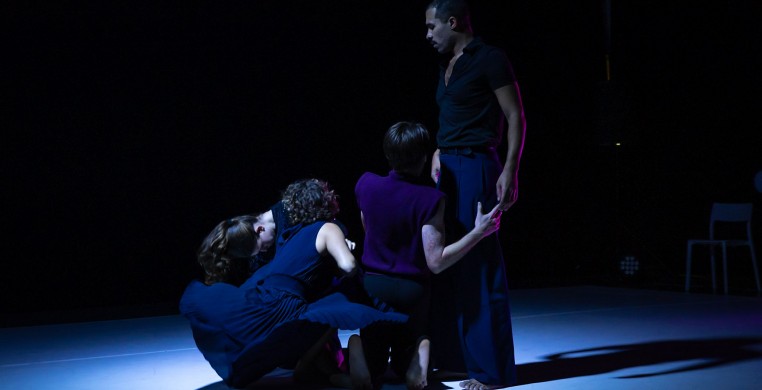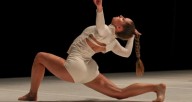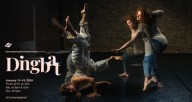Same Planet Performance Project thrives in the absurd with its newest work, Dingbat, choreographed by Artistic Director Joanna Read. Dingbat was presented at SPPP’s home base: The Garage at Dovetail Studios. "In a world that is both absurd and complex....instead of breaking we find ways to exist,” (Dingbat press release, 2024) SPPP not only exists within this absurd and complex world, but in its 27th year of creating work in Chicago, it is apparent that they continue to thrive.
The original premiere date of Dingbat was set for the weekend of January 12th, but after a winter storm passed through Chicago and the Covid-19 virus found its way into the ensemble, SPPP had to postpone. Just as their newest piece found itself conveying the resiliency and perseverance of the human condition, so did the company, and they were able to reschedule the weekend of performances, to the delight of the Chicago dance community.
While each audience member bought a ticket for the same show, each set of eyes witnessed something completely different. The 45 minute work took place in the center of the dance studio turned performance venue, with no designated front or back, and seating set up on opposing sides of the room.
One of the highlights of this show is that it does not predetermine the audience's experience through the traditional use of theater space. Rather, it leaves each patron with their own unique perspective based on where they are seated and what is taking place in front of them. Audience members, in full view of each other and seated on opposite sides of the performance area, involuntarily become part of the backdrop and dance. The public’s gaze becomes an intrinsic part of the work, each movement of a head or shifting of legs becomes part of the choreography.
A unique addition to the setup of the space was that the "off stage" holding area was visible to the audience. As dancers entered and exited the space, their presentation carried on as they sat in pre-set chairs backstage breathing heavily, and observing their peers. Many times I found myself looking over to the side, absorbed with the presence of the dancers "in the wings." It was a glimpse into the resilience of the performers, who we often take for granted as they make everything look so easy, when in fact they are putting their bodies through athletic intensity.
The structure of the space, and the bodies moving within it, made me think of how life is also performed “in the round." Other than time progressing in a linear path, the rest of our human experience is continuously varying. SPPP is not just presenting a story or perspective for us to ingest. Read has made us a part of the dialogue that she investigates in this work.
As the audience took their seats there was a sense of community and joy throughout the building. Clusters of peers sat and mingled, while others awaited the show in solitude, taking in their surroundings. Upbeat music played over the speakers, and lights were set to a soft blue glow, akin to the ambience of a night club. I will admit I found myself resisting the temptation to get up and dance to Black Sheep's 1991 hit "The Choice Is Yours".
 Same Planet Performance Project in Dingbat; Photo by Vin Reed
Same Planet Performance Project in Dingbat; Photo by Vin Reed
Music is a major force in Dingbat, and the work progresses through various sections divided by sound. The beginning is jarring and brings to mind the heavy current of a city street. A score of commonplace sounds such as feet on the floor, breathing, doors opening, fills the room, coincidentally echoed by the rain just outside the garage door. Later, as breath and limbs descend into the floor, the dancers create their own audible vibrations while a soft minimal sound score featuring bells plays.
The evening began with a beautiful solo by Chloe Michels, who demonstrated a delicate balance of grace and drive throughout the performance. Her soft and controlled movements were tempered by a musical score of pulsing rhythms and heavy beats. More dancers joined the space and the juxtaposition of the movement to sound score became less severe as new movement qualities emerged.
The ensemble broke into a moment of unison, walking across the stage in a row from side to side, without breaking stride. They acknowledge each other with subtle turns of the head, but there is clearly no recognition from person to person that they are being looked upon. Walking gives way to staccato migration through space, continuing in unity, but evolving with a purposeful energy. They then break off into sporadic movements, and individuality shines through as they soar across the floor.
A highlight of the event was a pair of solos by Patrick Burns and Juli Farley. Burns begins moving through the space in a way that I can only describe as gelatinous. As if his bones have melted, and the tendons became rubber, he drifts aimlessly throughout the room invoking a sense of anti-gravity .
Farley joins, adding a syncopated meter to the dance. As if she was an octopus pressed into an impossibly inconvenient container she adjusts her body by folding, twisting, and pulling her limbs out of the space. As soon as her arm reaches the end point of its pathway an invisible force pushes her into a new direction and the escape act begins again.
The evening ends with a choral piece that begins simply and peacefully but ruptures into a sinister vocalization. Each song is met with a new idea, whether it be staging, energy, or diversity of movement. Read's fine-tuned ear for how music can affect both the sequence and flow of movement manifests fully in Dingbat.
While there is no clear cut narrative to Dingbat, Read is able to masterfully create a catalog of movements and tableaus that invoke multiplicities by which everyday life is defined. There is a distinct cleverness in the work, as Read weaves together classical modern dance with contemporary gesture, and masterfully directs a talented ensemble through a thoughtfully constructed space.



